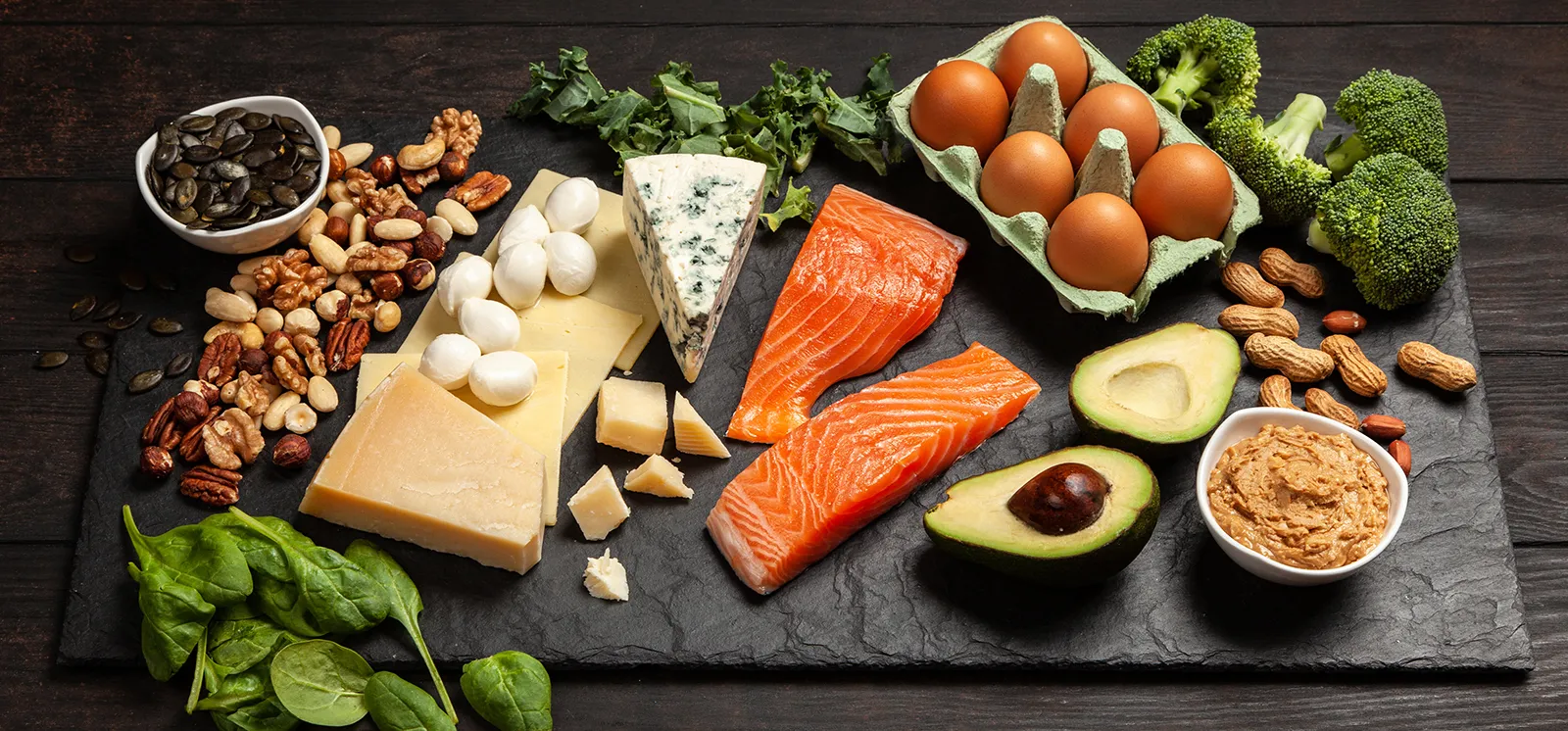The ketogenic diet, popularly referred to as keto, is a low-carb, high-fat diet that has gained immense popularity over the last decade. Initially designed for managing epilepsy, the diet has shown promising results in weight loss, diabetes management, and other health conditions. The diet primarily relies on limiting carbohydrate consumption and increasing healthy fats, prompting the body to enter a metabolic state called ketosis. In this state, the body efficiently burns fat and supports overall health improvements. This article delves into the types, benefits, and recommended meal plans in a ketogenic diet.
Introduction to the Ketogenic Diet
Definition and Basics of the Ketogenic Diet
The ketogenic diet is a low-carb, high-fat diet that involves drastically reducing carbohydrate consumption while upping the intake of healthy fats. By limiting carbs, the body switches to burning fats for energy, resulting in a metabolic state known as ketosis. The standard ketogenic diet (SKD) mainly comprises 75% fats, 20% protein, and 5% carbs.
Origins and Historical Use of the Diet
Originally developed in the 1920s, the ketogenic diet was prescribed to children with epilepsy to reduce seizure frequency. Over the years, the diet has evolved, encompassing various health benefits such as weight loss, diabetes management, and improved heart health.
Types of Ketogenic Diets
Standard Ketogenic Diet (SKD)
This is the most common and widely practiced ketogenic diet variation. It involves a high fat intake, moderate protein, and minimal carb consumption to achieve and maintain ketosis.
Cyclical Ketogenic Diet (CKD)
The cyclical ketogenic diet involves alternating periods of low-carb, high-fat intake with periods of higher carb consumption. This diet is usually followed by athletes to improve exercise performance without compromising ketosis.
Targeted Ketogenic Diet (TKD)
Targeted ketogenic dieting is ideal for those who engage in intense workouts. It permits increased carb intake around exercise periods.
High Protein Ketogenic Diet
This variation is similar to the standard ketogenic diet but with an increased protein intake, typically involving 60% fats, 35% protein, and 5% carbs.

The Process of Ketosis
Metabolic State
Ketosis is a metabolic state characterized by elevated ketone bodies in the blood. This occurs when the body switches from utilizing glucose (obtained from carbs) as its primary energy source to burning stored body fat.
Reducing Carbohydrate Intake
By limiting carb intake, keto dieters force their body to switch to fat as the primary fuel source, enhancing fat-burning processes and supporting weight loss.
Benefits of Ketosis
Apart from weight loss, ketosis also provides various health benefits such as improved blood sugar and insulin levels, increased brain function, reduced inflammation, and better energy levels.
Weight Loss and Health Benefits of the Ketogenic Diet
Effectiveness of the Diet for Weight Loss
The ketogenic diet is highly effective in shedding excess weight due to its innate ability to utilize fats for energy, which reduces hunger hormones and boosts satiety.
Benefits for Diabetes and Prediabetes
By lowering blood sugar levels, insulin sensitivity, and body weight, the ketogenic diet proves helpful in managing and reversing diabetes and pre-diabetes.
Other Potential Health Benefits
Studies indicate promising results for the ketogenic diet in treating other health conditions, including cancer, epilepsy, Alzheimer’s disease, Parkinson’s disease, polycystic ovary syndrome (PCOS), and brain injuries.
Ketogenic Diet Foods
Foods to Avoid
To adhere to a ketogenic diet, it is essential to avoid foods high in carbs. These include bread, pasta, sweets, sugary drinks, and certain fruits and vegetables.
Foods to Eat
Ideal foods for those following a ketogenic diet are high in healthy fats and low in carbs. Examples include fatty fish, omega-3-rich seafood, healthy oils (such as avocado oil), low-carb veggies, and high-quality dairy and meat products.
Sample Keto Meal Plan and Snacks
Meal Planning and Recipes
Creating a keto meal plan involves incorporating ketogenic-friendly ingredients such as leafy greens, fats like coconut oil, avocado, and proteins like chicken, beef, and fish. Some keto recipes include cauliflower rice and spinach stuffed chicken.
Keto-friendly Snacks
For snacks, keto dieters can indulge in nuts, seeds, cheese, or keto-approved snacks such as dark chocolate and berries.
Tips and Tricks for the Ketogenic Diet
Meal Planning and Food Choices
Planning meals ahead of time allows ketogenic dieters to make better food choices and avoid over-consumption of carbs. Additionally, focusing on whole foods and incorporating low-carb vegetables can make the diet more sustainable.
Eating Out and Social Situations
While eating out, it’s essential to choose menu options that align with the ketogenic diet. Common restaurant alternatives include bun-less burgers, salads with grilled proteins, and vegetable-heavy dishes.
Managing Side Effects and Risks
Keto dieters should be wary of the initial side effects, such as the infamous “keto flu.” Proper hydration, getting ample rest, and supplementing with essential minerals are crucial to reducing these risks.
Supplements for a Ketogenic Diet
MCT Oil
Medium-chain triglyceride (MCT) oil is a popular supplement among ketogenic dieters because it quickly converts into ketones and provides sustained energy levels.
Minerals
Electrolytes, such as sodium, potassium, and magnesium, are essential on a ketogenic diet to manage possible deficiencies, especially during the initial phase.
Other Beneficial Supplements
Exogenous ketones, creatine, and whey protein are additional supportive supplements for those following a ketogenic diet, ensuring better diet outcomes and overall health.
Risks and Concerns of the Ketogenic Diet
Long-term Effects
While the ketogenic diet has shown numerous short-term health benefits, its long-term effects are not entirely understood. Some experts argue that it might not be suitable for certain individuals with specific health conditions or needs.
Ketoacidosis
Ketoacidosis is a serious complication that can result from extremely high levels of ketones in the bloodstream. Although rare, it is essential to monitor overall health, ketone levels, and blood sugar while adhering to a ketogenic diet.
Monitoring Health While on the Diet
Regular check-ins with healthcare professionals and monitoring key health indicators can help ensure the ketogenic diet’s safe implementation. It is essential to watch symptoms and adjust the diet based on individual needs and responses.
As the ketogenic diet becomes increasingly popular for weight loss and health improvement, it is important to understand its intricacies and apply the principles that best suit each individual’s goals and needs. Whether the goal is to shed excess pounds or manage chronic health conditions, the ketogenic diet can become a powerful tool in one’s arsenal of healthy lifestyle choices.
FAQ
1. What exactly is the ketogenic diet?
The ketogenic diet is a high-fat, moderate-protein, and low-carb eating plan that aims to shift your body’s energy source from glucose to fat. By drastically reducing carbohydrate intake, the ketogenic diet forces your body into a metabolic state called ketosis. In this state, your body becomes highly efficient at burning stored fat for fuel, potentially leading to weight loss and other health benefits.
2. How does the ketogenic diet work?
The ketogenic diet works by depriving your body of carbohydrates, its primary energy source.When carb intake is low, your liver converts fatty acids into ketone bodies. These ketones become the main fuel source, replacing glucose. This state called ketosis promotes fat burning and leads to potential weight loss, improved mental clarity, and increased energy levels.
3. What are the health benefits?
The ketogenic diet offers several health benefits, including potential weight loss, improved mental clarity, and increased energy levels. It can help regulate blood sugar, reduce insulin resistance, and lower inflammation. Additionally, the ketogenic diet has shown promise in managing epilepsy, Alzheimer’s, Parkinson’s, and improving heart health.
4. What foods can I eat?
On a ketogenic diet, you can eat foods high in healthy fats and moderate in protein. These include meat, fatty fish, eggs, avocados, nuts, seeds, full-fat dairy, low-carb vegetables like leafy greens, healthy oils, and limited amounts of low-sugar berries.
5. What foods should I avoid?
In a ketogenic diet, avoid high-carb foods like sugary treats, grains, legumes, starchy vegetables, most fruits, and high-sugar beverages. Also, limit processed foods, unhealthy fats, and excessive amounts of protein.
6. How many carbs can I consume?
Typically, a ketogenic diet restricts carb intake to about 20-50 grams per day. This ensures the body reaches and maintains ketosis, allowing optimal fat burning and potential health benefits.
7. How do I know if I am in ketosis?
You can determine if you’re in ketosis by checking for symptoms like increased energy, mental clarity, and reduced hunger. Some people also use ketone testing strips to measure ketone levels in their urine, or blood and breath ketone meters for more accurate results.
8. What is the “keto flu,” and how can I prevent or manage it?
Keto flu refers to a group of symptoms like fatigue, headaches, and dizziness experienced by some individuals during the initial stages of the ketogenic diet. It occurs as your body adapts to ketosis. You can prevent or manage keto flu by staying hydrated, replenishing electrolytes, getting enough sleep, and gradually easing into the diet.
9. How can I maintain a social life and eat out while on a ketogenic diet?
To maintain a social life and eat out on a ketogenic diet, plan ahead by researching restaurant menus for keto-friendly options, ask for substitutions like salad instead of fries, and avoid high-carb sauces and dressings. Don’t be afraid to customize your order when needed.
10. Is it possible to build muscle while on this diet?
Yes, it is possible to build muscle on a ketogenic diet, given adequate protein and overall caloric intake. Resistance training and a diet providing sufficient nutrients, including essential amino acids, can support muscle growth even in a low-carb state.
11. How much protein should I eat?
Protein intake on a ketogenic diet should be moderate, usually around 15-30% of total calories. The exact amount depends on factors like age, gender, activity level, and body composition goals. Excess protein can be converted to glucose, potentially hindering ketosis.
12. How long does it take to enter ketosis, and what factors affect it?
Entering ketosis generally takes 2-4 days, but it can vary depending on factors like individual metabolic rate, carb and protein intake, exercise, and insulin sensitivity. Maintaining low carbohydrate intake, increasing physical activity, and incorporating intermittent fasting may help accelerate the process.
13. How is ketosis different from ketoacidosis, and is it dangerous?
Ketosis is a natural, healthy metabolic state, while ketoacidosis is a dangerous condition characterized by extremely high ketone levels and blood acidity. Ketoacidosis is typically a complication of uncontrolled Type 1 diabetes and is not a risk for most individuals following a ketogenic diet.
14. Can this diet help with conditions like diabetes, epilepsy, or Alzheimer’s disease?
Studies have shown that a ketogenic diet can help manage conditions like diabetes by improving insulin sensitivity and glycemic control. Additionally, it has been used as a treatment for epilepsy, particularly in children who don’t respond to medication. Research also suggests potential benefits for neurological conditions like Alzheimer’s and Parkinson’s disease.
15. Is this diet sustainable for long-term weight loss and overall health?
The ketogenic diet can be sustainable for long-term weight loss and overall health when followed correctly and tailored to individual needs. It’s essential to prioritize nutrient-dense foods, avoid overly restrictive eating patterns, and regularly assess your progress. Always consult a healthcare professional before beginning any new diet plan.



